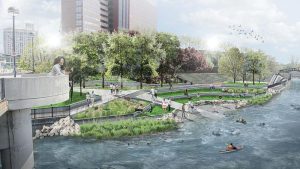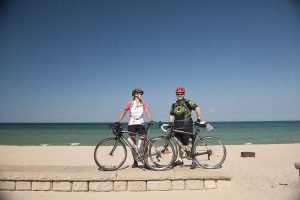By Mary McGuire
While people were looking for ways to be active during the 2020 COVID-19 pandemic, Michiganders made a serious beeline to parks, trails, and recreation areas. So much so, that Michigan’s state parks, trails, and recreation areas experienced a 30% surge in attendance, a level that had not been seen in generations. As a result, a movement emerged to increase outdoor recreation by improving parks and trails.
Building Michigan Together
On March 11, 2021, President Biden signed the American Rescue Plan Act into law. Michigan received $250 million in federal relief dollars to invest in and modernize Michigan’s state parks and recreation system. This important initiative became part of Michigan’s bipartisan Building Michigan Together Plan which is a nearly $5 billion infrastructure bill designed to “grow the economy, create jobs, and benefit families in every region of the state.”
In June of 2021, surrounded by the blue green waters of the Straits of Mackinac and the Mackinac Bridge in Straits State Park, Governor Gretchen Whitmer shared her administration’s plans “for critical investments in state parks and trails so that public spaces across Michigan become a more attractive destination for tourism and position the state as a recreation leader.”
The Building Michigan Together plan authorized $250 million the Department of Natural Resources to help modernize Michigan’s award-winning, 103-year-old state parks and recreation system. Up to $30.2 million will go toward the creation of a new state park in Flint. The remaining funding will go toward a backlog of infrastructure maintenance projects on aging historic structures: camping facilities, paved and natural surface trails, parking lots, restrooms, water and sanitary systems, for example.

An additional $200 million will benefit local park systems, including $65 million to be administered through the Michigan Spark Grants Program and $135 million for dedicated greenway projects in Detroit, Grand Rapids and the U.P.
By investing $450 million in Michigan’s state parks, the Building Michigan Together Plan will also provide safe affordable places for Michiganders to be active, enhance tourism and boost the outdoor recreation industry.
“The Building Michigan Together Plan makes bold, bipartisan investments in the kitchen-table issues that matter most to Michigan families, including clean water, smooth roads, fast internet, and beautiful parks,” said Governor Whitmer in her March 28, 2022 press release.
Infrastructure for future generations
Michigan has over eight million acres of land accessible to the general public, 12,000 miles of state trails, and the second longest coastline providing access to the Great Lakes, rivers, and streams. Maintenance of infrastructure is always ongoing, but upgrades to critical infrastructure in state parks and recreation areas are often costly yet needed to ensure Michigan state parks, trails, and campgrounds remain world-class outdoor recreation destinations that bring people back for generations.

Current projects can be found on the Building Michigan Together: State Park and Trail Projects dashboard. Examples of current projects include replacing fishing piers at Yankee Springs Recreation Area, traffic improvements and upgrades to day-use parking, pedestrian crosswalks, and playscape drop-off areas at Bay City State Park, modernizing overlooks at Tahquamenon Falls State Park, upgrading electrical systems and historic structures at Hartwick Pines State Park, upgrading green space areas at Belle Isle State Park, and ADA compliance upgrades in multiple parks and recreation areas.
Quiet on the set
From this investment, the state was able to invest in its newest park, the Saginaw River Headwaters Recreation Area at the old General Motors site. It boasts wetlands, shallow-water ponds, and forested river corridors across 334 acres of passive recreation land. The property also includes a nature preserve and three miles of developed trails, all situated alongside the Saginaw river. This is the first state park of its kind to focus on quiet sports like walking, hiking, biking, birding, fishing, kayaking, and sledding.
Shifting focus
The State of Michigan also shifted the Office of Outdoor Recreation Industry out of the Michigan Department of Natural Resources (MDNR) and into the Michigan Economic Development Corporation (MEDC). This transition underscores how the outdoor recreation industry has now become vital infrastructure and a significant contributor to Michigan’s economy. The shift is working as Michigan is focused on growing outdoor recreation assets, businesses, products, talent, and spurring innovation. Between 2020 and 2022, the state’s outdoor recreation economy increased by 15%, according to the Bureau of Economic Analysis, Outdoor Recreation Satellite Account and Regional Economic Accounts. According the MEDC, “Michigan’s Outdoor Recreation economy contributed $12.6 billion in value-add in 2022, supporting 119,000 jobs and $5.6 billion in compensation to employee households.”
At the national level, the National Recreation and Parks Association states “there are more than 10,000 park and recreation agencies, providing parks, trails, and other public outdoor and indoor spaces in nearly every city, town, and county across the United States.” They also found that “nearly nine in 10 people agree that it is important for local, state and federal governments to fund local park and recreation agencies sufficiently in order to ensure every member of the community has fair access to amenities, infrastructure and programming.”
Better health
In addition to promoting active lifestyles that contribute to better mental and physical health, parks and recreation areas play a crucial role in reducing air pollution by removing pollutants and lowering air temperatures through trees and vegetation. They also increase home values and property tax bases, while serving as vital resources for community emergency response efforts.
The investment in outdoor recreation is good news for Michiganders because it provides space to be active. According to the Michigan Department of Health and Human Services (MDHHS) 2021 Michigan Behavioral Risk Factor Survey, regular physical activity can reduce the risk of many diseases including cardiovascular disease, diabetes, osteoporosis, and more. Keeping active can also help control weight, support healthy bones, muscles, and joints, and relieve symptoms of depression.
“Having low cost/no cost access to parks, trails, and recreation areas provides opportunities for Michiganders to move more,” said Michigan Fitness Foundation Vice President of Program Marci Scott. “Having access to recreational spaces and the infrastructure to support outdoor recreation can inspire and empower Michiganders to prioritize outdoor recreation as the fun, safe, healthy, and easy choice, and that is good for public health.”

